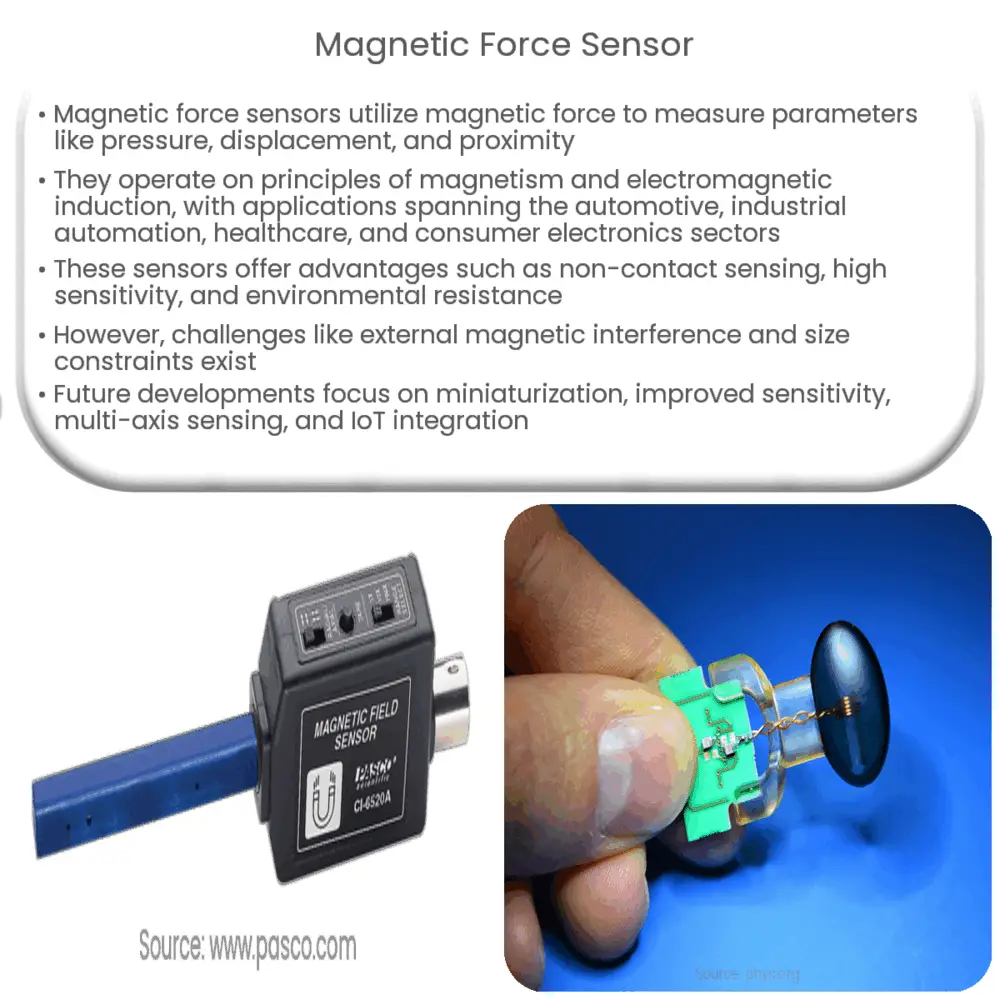Magnetic force sensors utilize magnetism to measure parameters like pressure, displacement, and proximity, offering non-contact sensing across various industries.

Magnetic Force Sensor: Revolutionizing Sensing Technology
Introduction
In recent years, the development and application of advanced sensing technologies have been transforming various industries. One such cutting-edge technology is the magnetic force sensor. This innovative sensor utilizes magnetic force to measure various parameters, such as pressure, displacement, and proximity. This article explores the fundamental principles of magnetic force sensors, their applications, advantages, and challenges.
Working Principle of Magnetic Force Sensors
Magnetic force sensors operate based on the fundamental principles of magnetism and electromagnetic induction. In their simplest form, these sensors consist of two key components: a magnet and a sensing element. The magnet generates a magnetic field, while the sensing element is responsible for detecting changes in this field due to the presence of an external force or object.
As a force or object interacts with the magnetic field, it alters the field’s distribution. This change is detected by the sensing element, which usually consists of a coil or a Hall effect sensor. The sensing element then converts the change in magnetic field into an electrical signal, which can be processed and analyzed to determine the force or distance of the interacting object.
Applications of Magnetic Force Sensors
Magnetic force sensors have numerous applications across various industries, including:
- Automotive: In the automotive industry, magnetic force sensors play a crucial role in measuring parameters such as brake pedal force, clutch pedal force, and suspension system displacement. This information helps ensure vehicle safety and optimize performance.
- Industrial Automation: In industrial automation, these sensors are used to monitor and control processes such as robotic arm positioning, conveyer belt speed, and machine tooling. This enables precise control and real-time feedback for increased efficiency and productivity.
- Healthcare: Magnetic force sensors have found applications in the healthcare sector as well. They are used in medical devices to measure blood pressure, muscle tension, and respiratory rate, contributing to accurate diagnosis and patient monitoring.
- Consumer Electronics: In consumer electronics, these sensors are employed in devices such as smartphones, tablets, and gaming consoles to enable touchless control and gesture recognition.
Advantages of Magnetic Force Sensors
There are several advantages to using magnetic force sensors in various applications, including:
- Non-contact Sensing: As magnetic force sensors can measure forces and distances without physical contact, they are less prone to wear and tear, ensuring a longer operational lifespan.
- High Sensitivity and Resolution: These sensors offer high sensitivity and resolution, allowing for precise measurements even in challenging environments.
- Wide Measurement Range: Magnetic force sensors can measure forces and distances over a wide range, making them suitable for numerous applications.
- Resistance to Environmental Factors: These sensors are less affected by environmental factors such as dust, moisture, and temperature, ensuring reliable performance in various conditions.
Challenges and Limitations of Magnetic Force Sensors
Despite their numerous advantages, magnetic force sensors also face some challenges and limitations:
- External Magnetic Interference: The performance of magnetic force sensors can be affected by the presence of external magnetic fields, which can cause measurement errors. Shielding techniques or compensation algorithms may be required to minimize this interference.
- Temperature Dependence: Although these sensors are generally resistant to temperature variations, extreme temperature changes can still impact their performance. Temperature compensation techniques may be necessary to ensure accurate measurements in such conditions.
- Size and Weight: Some magnetic force sensors, particularly those with large magnets, can be bulky and heavy. This may limit their suitability for certain applications where size and weight constraints are critical.
Future Developments and Trends
As the demand for advanced sensing technologies continues to grow, researchers and manufacturers are working to overcome the limitations and enhance the capabilities of magnetic force sensors. Some key trends and developments include:
- Miniaturization: Efforts are being made to reduce the size and weight of magnetic force sensors without compromising their performance. This will enable their use in a wider range of applications, particularly in the field of wearable technology and consumer electronics.
- Improved Sensitivity and Resolution: Researchers are exploring novel materials and designs to enhance the sensitivity and resolution of magnetic force sensors, allowing for even more precise measurements.
- Multi-axis Sensing: The development of multi-axis magnetic force sensors will enable the simultaneous measurement of forces and distances in multiple directions, further expanding their applications and utility.
- Integration with IoT: The integration of magnetic force sensors with the Internet of Things (IoT) will enable real-time monitoring, data analysis, and remote control of various processes, contributing to the ongoing evolution of smart systems and devices.
Conclusion
Magnetic force sensors have emerged as a revolutionary sensing technology with numerous applications across various industries. Their non-contact sensing, high sensitivity, wide measurement range, and resistance to environmental factors make them a valuable asset in automotive, industrial automation, healthcare, and consumer electronics sectors. As researchers and manufacturers continue to innovate and overcome the challenges associated with magnetic force sensors, their potential will only continue to grow, driving further advancements in sensing technology and its applications.

